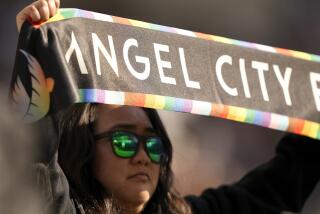Just How Far Will Tiger’s Impact Reach?
- Share via
The president of the United States stood at Shea Stadium on Tuesday, praising the courage and humanity of Jackie Robinson. But the president received one of the biggest roars of the night when he uttered these two words: Tiger Woods.
Things have changed greatly for Woods this past week, what with that green jacket and an investment in a theme restaurant and the worship of the nation’s sports fans.
But for those kids who are supposed to be represented in the ubiquitous “I Am Tiger Woods” campaign -- black, Hispanic and Asian children, the children who look more like Woods than any other golfer they’ve seen -- for them, not much has changed at all.
That Nike commercial, deftly implying that Woods’ compelling personality will draw minority children and little girls and any old inner-city kid to the game, doesn’t address the more pressing issues. Where will they play? How will they afford the greens fees? Who is going to buy their equipment? Though Woods may have awed the masses in every neighborhood last weekend, even he cannot pry open the gilded clubhouse doors for the children of Crown Heights or Harlem. After his victory, Woods -- a walking melting pot of black, American Indian and Thai heritage -- predicted that more children than ever before will enter the game. No doubt, kids of all backgrounds are attracted to Woods because he looks as if he could be their older, albeit wildly successful, brother.
“Since Tiger Woods began playing, it’s becoming an interesting game,” said Kwame Applewhite, 14, a Brooklyn eighth-grader. “I catch myself watching golf more than basketball. I’d really like to learn it. Maybe in the summer.”
But it is hard to imagine a well-manicured green in neighborhoods where the only patches of grass are strewn with intravenous needles.
“They (schoolchildren) were ecstatic about the fact that he had broken records and then they wanted to know more about golf,” said Alice Holloway, a gym teacher at MS 320, the Jackie Robinson School built next to the housing projects where Ebbets Field once stood. “It’s not a field we’re easily accepted in and with the expense of it, for New York children, who don’t even have space to play, golf is an abstract thought. It’s impossible to get on a course. And just the idea of children playing in the neighborhoods we’re surrounded by -- parents aren’t willing to let their children out in front of the building.
“We have one gym and 1,500 children. To think of playing golf is inconceivable.”
Indeed, New York’s children may now talk about Woods with the reverence previously reserved only for Michael Jordan. “He has a lot of skills,” said Kimberley Ennis, 14, of MS 320. “It’s absolutely amazing.” But to play Air’s game, children need only a basketball and a schoolyard hoop. To play Tiger’s game, well, that’s a little more complicated. At Marine Park Golf Course in Brooklyn, greens fees for juniors are $7.50. To rent a set of clubs for the afternoon is $10. Not outrageous, but it’s notoriously difficult to get a tee time on public courses in the Northeast.
According to the National Golf Foundation, there were 2 million golfers ages 12 to 17 at the end of 1996. Judy Thompson, a spokeswoman for the foundation, expects to see an uptick in numbers this year, capitalizing on Woods’ surge and the overall boom in golf. How big is golf now? Nike is projecting that fiscal year 1998, which starts June 1, will produce $180 million in golf business, a 60 percent increase over the current fiscal year. And the Woods clothes and shoe collection haven’t even appeared in stores yet.
After being signed by Nike, Woods created the Tiger Woods Foundation. That group is formulating plans with Nike to sponsor a series of clinics for children. “He likes to be looked at as a role model,” Nike spokeswoman Robin Carr said. “He doesn’t want to do quick hits. He wants to see long-term programming.”
When Woods went to the Phoenix Open -- where, as in Florida, public courses and driving ranges are plentiful -- to do a clinic with Phil Mickelson and Billy Mayfair, 3,000 children showed up.
“It looked like a rainbow,” said Bill Dickey, interim president of the National Minority Golf Foundation, a sister organization to the Tiger Woods Foundation.
More to Read
Go beyond the scoreboard
Get the latest on L.A.'s teams in the daily Sports Report newsletter.
You may occasionally receive promotional content from the Los Angeles Times.










